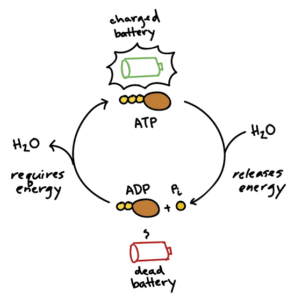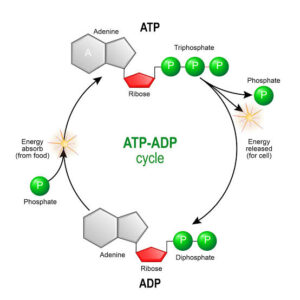Back to: Botany 400 Level
Hello there, my incredible Afrilearn scholar! I hope you’re ready for another exciting journey through the fascinating world of plant physiology! Today, we’re going to be looking at a very important topic: ATP synthesis and energy transfer. ATP (adenosine triphosphate) is often called the energy currency of cells, and understanding how it’s made and transferred is crucial to understanding how plants and all living organisms function. By the end of this lesson, you’ll know how plants make ATP, how they transfer energy, and why this is so important for life. Let’s get started!
ATP synthesis and energy transfer
Let’s take a moment to think about what keeps you going throughout the day. You get energy from the food you eat, right? Your body breaks down that food into usable energy. Now, plants also need energy to grow, produce leaves, flowers, and even fruits. But how do plants use energy? The key to understanding plant energy is ATP. ATP is like the battery that powers a plant’s cell. Without it, nothing would work in the plant! So, how do plants make ATP? And how do they transfer it around? Let’s find out!

ATP Synthesis
ATP is made in the mitochondria (for most organisms) and chloroplasts (in plants during photosynthesis). It’s made during a series of reactions that start with breaking down food, like glucose. Let’s look at the process:
Glycolysis: The first step of ATP production is glycolysis, where glucose (a type of sugar) is broken down into smaller pieces called pyruvate. This process releases a small amount of ATP.
Krebs Cycle: After glycolysis, pyruvate enters the mitochondria, where it is further broken down in a cycle called the Krebs Cycle. This cycle generates energy carriers (NADH and FADH2), which are used in the next step to produce more ATP.
Electron Transport Chain (ETC): In this final stage, NADH and FADH2 donate electrons to the Electron Transport Chain, which is located in the inner membrane of the mitochondria. As electrons move through the chain, they release energy, which is used to pump protons across the membrane. The protons flow back through a protein called ATP synthase, and this movement powers the production of ATP.
ATP: The final result is the production of ATP. This molecule is like a charged-up battery that can be used for various activities inside the plant cell, such as growth, repair, and maintaining cellular functions.
Example:
Think of ATP like a phone battery. To charge it, you need to plug your phone in (the glucose breakdown process). The phone (plant) can then use that battery (ATP) to power different apps (plant functions). If the battery is low, the plant will struggle to do all its activities.
Energy Transfer in Plants
ATP doesn’t stay in one place for long; it needs to be transferred to different parts of the plant cell to do work. Here’s how the process works:
Energy Transfer: ATP carries energy within the cell to areas that need it. When ATP is used, it loses one of its phosphate groups and turns into ADP (adenosine diphosphate). When this happens, the energy stored in the high-energy bond between the phosphate groups is released and can be used to power processes like protein synthesis, cell division, or even moving materials around the cell.
Regeneration of ATP: After ATP loses a phosphate group and turns into ADP, the cell can regenerate ATP by adding a phosphate group back to the ADP. This process is powered by energy derived from glucose breakdown or light energy during photosynthesis.
Example:
Imagine ATP is like a battery-powered light. When the light is on (ATP), it’s working hard to do things like growing new leaves. But once the battery runs out (ATP loses its phosphate group and becomes ADP), the light goes off, and the cell has to recharge the battery before it can work again.
ATP and Photosynthesis
In plants, ATP is also produced during photosynthesis, which happens in the chloroplasts. When plants use sunlight to convert carbon dioxide and water into glucose (food), they also produce ATP as part of the process. This ATP is then used for other cellular processes, including energy storage and growth.
In the light-dependent reactions of photosynthesis, the energy from sunlight is used to produce ATP and NADPH (another energy carrier). This ATP is then used in the Calvin Cycle to help convert carbon dioxide into glucose. So, in plants, ATP is like the bridge between the energy from the sun and the plant’s ability to grow and function.

Example:
Think of photosynthesis as cooking food. The sunlight is the energy you need to cook, and the ATP produced during this process is like the stove that makes the food ready to eat. Without ATP, the plant wouldn’t be able to “cook” the food it needs to grow.
Summary
ATP synthesis happens in the mitochondria (and chloroplasts in plants), where glucose is broken down to create ATP. This ATP is the energy currency of the cell.
ATP is used by plant cells to perform essential functions such as growth, protein synthesis, and transport.
Energy transfer happens when ATP loses a phosphate group and turns into ADP, releasing energy that powers various cell activities. ATP is then regenerated to continue the process.
Photosynthesis in plants also produces ATP, which is essential for the plant’s growth and metabolism.
Evaluation
- Where is ATP synthesized in plant cells?
- What happens when ATP loses one of its phosphate groups?
- How does ATP help the plant cell perform essential functions?
- How is ATP involved in photosynthesis?
You’ve learned a lot about ATP synthesis and energy transfer today! Just like you need energy to perform your daily tasks, plants also rely on ATP to carry out their life-sustaining activities. Keep up the great work, and remember, each lesson is a step towards mastering plant physiology. I can’t wait to see you in the next lesson—keep growing and glowing! You’ve got this!
